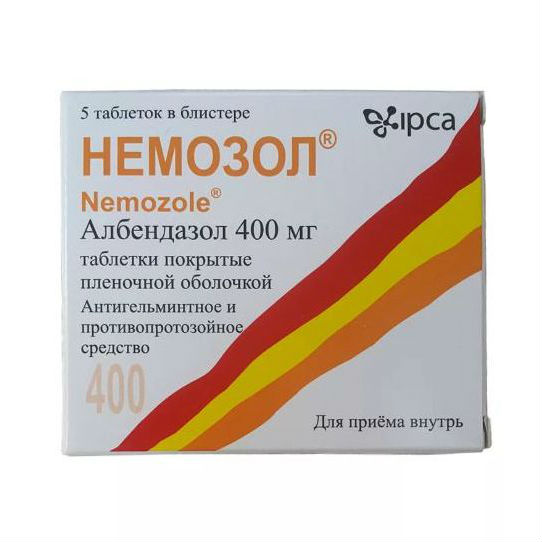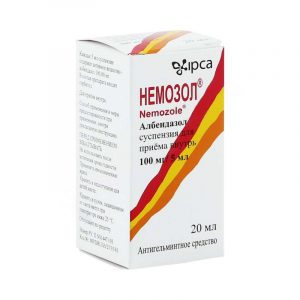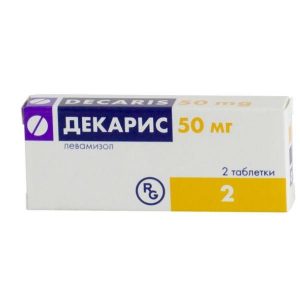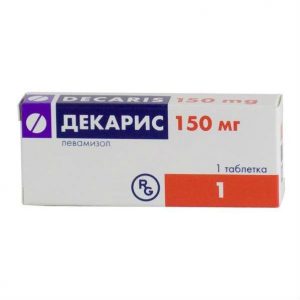Description
Release form
Film-coated tablets
Indications
– Nematoses:
ascariasis, pathogen – round helminth Ascaris lumbricoidesl
trichocephalosis (whipworm), pathogen – round helminth Trichocephalus trichiurus
enterobiosis (pinworms), pathogen – round helminth Enterobius vermicularis
hookworms (crankheads), pathogens – Ancylostoma duodenale, toxidocrispollis trichlebellus trichinella trichrinella Giardia intestinalis
stigiloidosis (intestinal acne), the causative agent is the round helminth Strongiloides strcoralis, as well as mixed invasions.
– tissue cestodoses:
Neurocysticercosis, pathogen – Cysticercus cellulosus (larval stage of pork tapeworm)
hydatidosis echinococcosis of the liver, lungs, peritoneum, pathogen – Echinococcus granulosus (larval stage of canine tapeworm)
as an aid in the surgical treatment of alveolar echinococcosis, pathogen – Echinococcus multilocularis.
Contraindications
– Hypersensitivity to albendazole, other components of the drug and other benzimidazole derivatives
– retinal pathology
– children under 3 years of age (for this dosage form)
– pregnancy and the period of breastfeeding
Precautions
The drug albendazole is used with caution in case of impaired liver function (necessary before and during time of treatment to regularly monitor liver function), inhibition of bone marrow hematopoiesis, cirrhosis.
Use during pregnancy and lactation
The drug albendazole is contraindicated during pregnancy and during breastfeeding.
Special instructions
It is recommended that all family members be treated concurrently.
Recommended monitoring of the cellular composition of the blood in the event of leukopenia suspend drug therapy.
In case of neurocysticercosis with eye damage, retinal examination is necessary before starting treatment because of the risk of aggravating its pathology.
In women of childbearing age, a pregnancy test is performed before starting treatment. During therapy and within 1 month after its completion, reliable contraception is necessary.
It should be remembered that before using Nemozol, like any other anthelmintic drug, you should carefully clean the room, wash children’s toys, daily (morning and evening) hygiene procedures, change of underwear. During treatment and several days after taking the drug, it is advisable to change the bed linen more often or iron it with a hot iron.
The simultaneous use of albendazole and theophylline can lead to an increased risk of toxic effects of theophylline (nausea, vomiting, heart palpitations, seizures). Although single doses of albendazole do not inhibit theophylline metabolism, nevertheless, albendazole induces cytochrome P4501A in hepatocytes. In this regard, it is recommended to monitor plasma concentrations of theophylline during treatment with albendazole.
Patients should avoid eating grapefruit products while taking albendazole, as plasma concentrations of albendazole may increase, which increases the risk of adverse reactions.
Influence on the ability to drive vehicles,
mechanisms Avoid driving and engaging in other potentially dangerous activities that require increased concentration and speed of psychomotor reactions, as the drug may cause dizziness and other side effects that may affect these abilities.
Composition
Each film-coated tablet contains:
Active ingredient:
albendazole – 400.00 mg
Excipients:
corn starch – 83.00 mg,
dried corn starch – 10.00 mg
sodium lauryl sulfate – 5.00 mg,
povidone (polyvinylpyrrolidone K 30) – 5.00 mg,
methyl parahydroxybenzoate – 0.360 mg,
propyl parahydroxybenzoate – 0.040 mg,
gelatin – 5.50 mg, 5.50 mg 0.50 mg, 5.50 mg sodium carboxymethyl starch – 5.20 mg,
silicon dioxide colloidal – 3.00 mg,
magnesium stearate – 3.00 mg.
Shell:
hypromellose – 5.32 mg,
titanium dioxide – 3.20 mg,
talc purified – 1.60 mg,
sodium lauryl sulfate – 0 mg,
macrogol 400 – 0 mg,
propylene glycol – 1.60 mg.
Dosage and administration
Inside, during or after a meal. Special training and diet are not required. The dosage form is selected individually, depending on the convenience of taking the drug and the tolerability of its constituent substances.
The dose of the drug is set individually, depending on the type of invasion and the patient s body weight.
The maximum daily dose is 800 mg.
In children, whenever possible, avoid the use of high doses of albendazole for a long time.
With nematodoses (including ascariasis, trichocephalosis, nekatorosis)
The standard dose for the treatment of roundworm infestations for adults and children weighing 60 kg or more is 400 mg per day once
for adults and children weighing less than 60 kg -15 mg / kg body weight once or in 2 doses .
With enterobiasis, adults and children over 3 years of age take the drug at a dose of 400 mg once. If necessary, after 14 days, repeat the treatment in the same dose and in the same mode.
In case of strongyloidosis, hookworm, adults and children over 3 years old take the drug in a dose of 400 mg once for 3 days. If necessary, after 7 days, repeat the treatment in the same doses.
With trichinosis, the drug is taken 400 mg 2 times a day for 10-14 days. In severe invasion and organ damage (myocarditis, pneumonitis, meningoencephalitis) glucocorticosteroid and symptomatic agents are also accepted.
For toxocariasis, adults and children over 14 years of age and weighing more than 60 kg take 400 mg 2 times a day for 10 days, with a body weight of less than 60 kg 200 mg. Repeated courses of treatment are required at intervals of 2 weeks / month. In the process of treatment, control of peripheral blood (once every 5-7 days) and aminotransferases is necessary at the same time.
With giardiasis: 400 mg 1 time per day for 3 days. Children weighing less than 10 kg -200 mg once a day once for 5 days.
With mixed invasions, the drug is taken 400 mg 2 times a day, for 3 days. If necessary, the course of treatment can be repeated after 1 month.
With neurocysticercosis and hydatidosis echinoccosis, patients with a body weight of 60 kg or more should take 400 mg 2 times a day, with a body weight of less than 60 kg – based on 15 mg / kg of body weight per day in 2 divided doses, the maximum daily dose is 800 mg. The course of treatment for neurocysticercosis is 28-30 days (2 days before taking the drug and in the first week of taking glucocorticosteroid drugs), with echinococcosis – 3 cycles of 28 days with a 14 day break between cycles.
Before using the drug, a clinical blood test and a biochemical blood test are necessary. Treatment is carried out with normal laboratory parameters. In the process of treatment, a blood and aminotransferase test is carried out every 5-7 days.
With a decrease in white blood cells below 3, 0x109 and a 2-fold increase in the activity of aminotransferases, it is necessary to suspend treatment until normal indicators.
Therapy with the drug can be resumed after the laboratory parameters return to the level that was before the start of therapy, however, during the laboratory tests should be carried out regularly.
The appointment of hepatoprotectors during treatment and in cases of toxic manifestations is ineffective, drug withdrawal is necessary.
Treatment with albendazole alveolar echinococcosis is an additional treatment.
Doses and regimen of the drug are the same as with hydatidosis echinococcosis. The duration and course of treatment is determined by the patient’s condition and tolerance to the drug.
Side effects of the
From the digestive system: impaired liver function with a change in functional liver tests (mild or moderate increase in the activity of liver transaminases), hepatitis, acute liver failure, epigastric pain, anorexia, constipation, diarrhea and dry mouth. nausea, vomiting.
From the hemopoietic system: inhibition of bone marrow hematopoiesis (leukopenia, granulocytopenia, agranulocytosis. thrombocytopenia, pancytopenia, aplastic anemia, suppression of bone marrow activity, neutropenia).
From the cardiovascular system: increased blood pressure.
From the central nervous system: headache and dizziness, meningeal symptoms, increased intracranial pressure.
From the urinary system: a change in indicators of kidney function (acute renal failure).
From the skin: itching, skin rash, multimorphic erythema, Stevens-Johnson syndrome.
Allergic reactions: angioedema, immediate hypersensitivity reactions.
Other: hyperthermia, alopecia.
If any of the side effects indicated in the instructions are aggravated, or you notice any other side effects not listed in the instructions, inform your doctor.
Drug Interactions
The simultaneous use of albendazole with iraziquantel, dexamethasone and cimetidine can increase the concentration of albendazole sulfoxide in the blood. Concomitant use with carbamazepine, phenytoin, phenobarbital and ginseng can lead to a decrease in the concentration of the drug albendazole in the intestine.
Overdose
Symptoms: increased dose-dependent side effects.
Treatment: gastric lavage, use of activated carbon, symptomatic therapy.
Storage conditions
Store in a dry, dark place at temperatures below 25 ° C.
Keep out of the reach and sight of children.
The Expiration of
is 3 years.
Active ingredient
Albendazole
Terms leave through pharmacies
In retseptu
lekarstvennaja form
tablets




